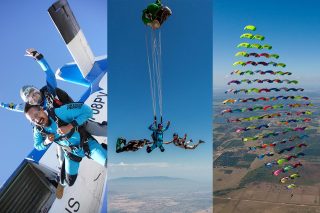An Interview with VFS Team Tempest
Skydiving
Posted by: Skydive Perris
5 years ago
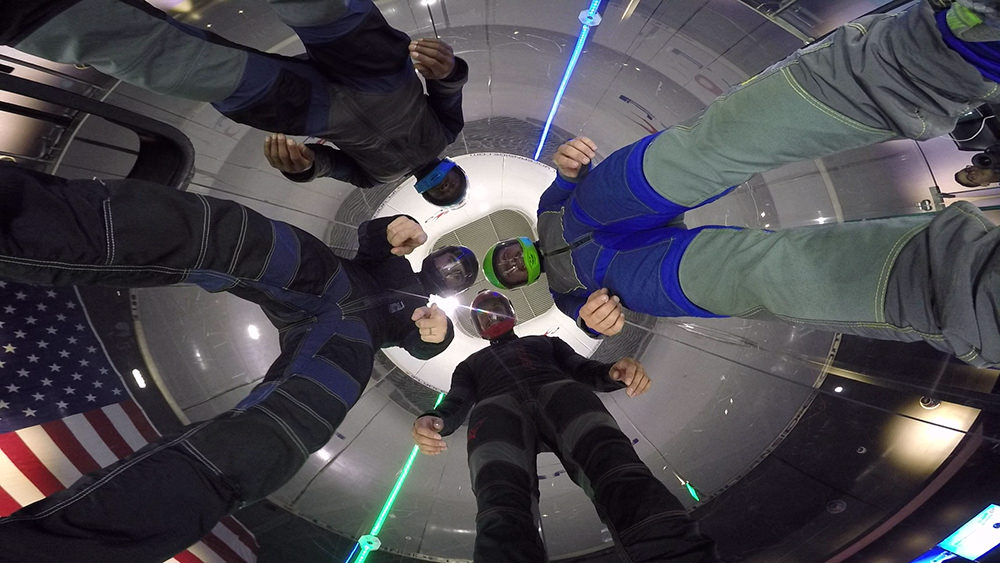
Vertical Formation Skydiving (VFS) is that discipline of the sport where you fly upside down on your head, or in a head up position, flying relative to other skydivers who are in same, or opposite orientation. It’s fast and it’s exciting and it’s one of the most progressive disciplines in our sport!
On a VFS team, 4 members of the team perform a sequence of freefall formations in a vertical axis, with their 5th member of the team capturing everything on camera for the judges. Points are awarded for successful completion of a select few predetermined formations from the dive pool of possible 22 blocks and 16 random formations. In competition, jumps are made from 13,000ft and teams have just 35 seconds of working time to show the judges their stuff! Just 5 or 6 formations are selected for each round of competition. It takes A LOT of practice to get good. When you’re flying head down or head up, freefall speeds can reach up to 180mph! Imagine being able to fly your body so precisely head up or head down to be able to turn multiple points and smoothly dock on your team mates at these speeds! You’ve got to be dedicated. You’ve got to be focused. You’ve got to be willing to sacrifice. You’ve got to be willing to sweat and bleed. Oh and you definitely need to develop a taste for Ramen noodles! But the reward of building the team, of going on that journey with your team mates and developing those skills, of becoming that badass VFS flyer that you’ve always dreamed to be and that thrill of competition to top it all off is just SO WORTH IT to these dedicated competitive skydivers.
Here at Skydive Perris competitive VFS is the all consuming passion of 5 of our full time skydiving instructors who make up Team Tempest! These guys have been training hard all year in their time off from instructing and are at the top of their game and we’re SO PROUD to say that they represent Skydive Perris!! We sat down with them to get the scoop as they finish up their training and preparation prior to the 2019 USPA Nationals, which this year is being held at Skydive Paraclete XP, Raeford, North Carolina, September 11 – September 27.
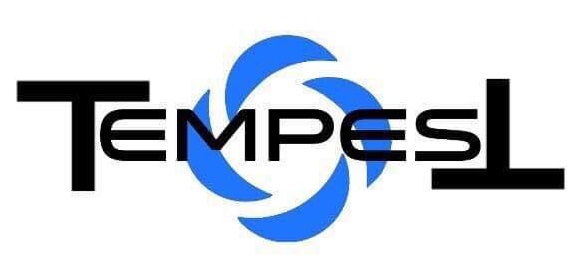
Kenny Beach: 5000 jumps, started jumping in 2009, originally from Michigan
Kyle Goldammer: 1900 jumps, started skydiving in 2014, home grown Californian
Chris “Rooftop” Harris: 1600 jumps, started skydiving in 2010, originally from Alabama
Justin Hooper: 2300 jumps, stated jumping in 2011, originally from Washington State
Dave Hebert (video): 8000 jumps, started jumping in 1998, originally from Quebec, Canada
Team training – 100 training jumps, 16+ hrs in the tunnel (so far).
Competing at Nationals – Advanced category.
How did team TEMPEST form?
[Kenny] Tempest formed while Kyle and I were back in Michigan talking about our interest in competing in VFS. We made the decision to move to Perris with hopes that we’d find people to build a team with. Once we got to Perris, we met Justin and Chris (Rooftop) who had already been flying 2-way together in tunnel and who happened to be looking for two others to join them. After a couple weeks of all four of us flying together, we noticed how much we were improving and decided to train for 4-way VFS to compete in the 2019 USPA National Championships. We really feel that we lucked out in that we all just happened to be looking for potential teammates at the same time and the same place.
[Rooftop] I met Justin at the end of a day of fun jumping on the packing mats at Perris. He was asking anybody and everybody if they wanted to go to the tunnel that night and I was the only one who wanted to go. We started flying “2-way” in the tunnel that night (he was basically coaching me since I had just learned how to transition and fly on my head). We kept flying a couple times a week after that. I started to progress with my skills and Justin started talking about getting a VFS team started. We looked for 2 more flyers for what seemed like forever but nobody seemed like they wanted to commit to flying a couple times a week in the tunnel, much less, training for Nationals. Then, one day, out of nowhere, Justin said he had 2 more guys (Kenny & Kyle) that were going to fly with us in the tunnel that night who were also interested in flying VFS. Not really sure after that but it escalated pretty quickly.
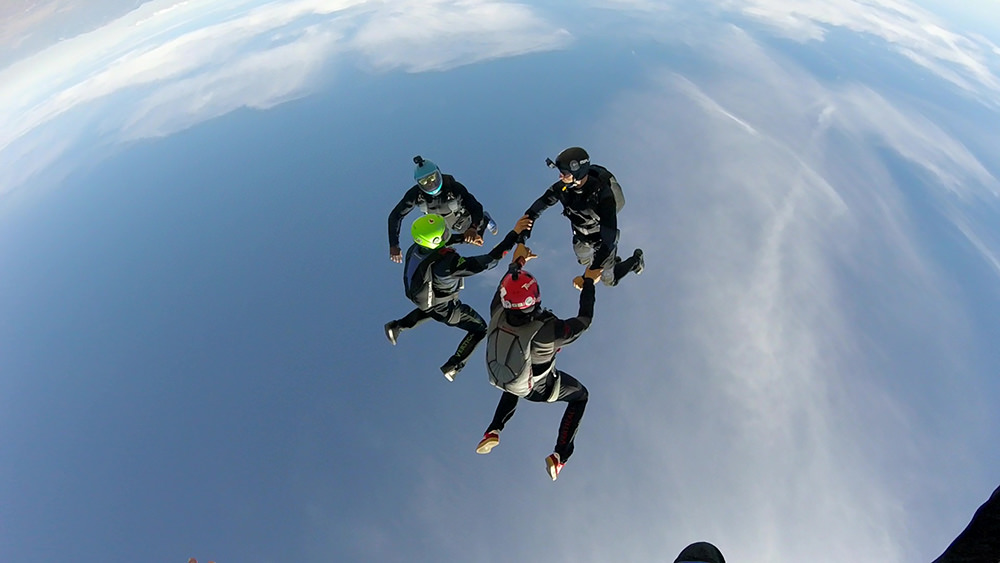
When did you decide you wanted to compete in VFS?
[Kenny] I have wanted to compete in VFS since 2010 when I happened across a video of Arizona Arsenal flying VFS in the tunnel and was immediately drawn to it. Although I only had about 10 jumps at the time and was a student, I began learning the dive pool.
[Justin] I competed at nationals for 4 way VFS in 2018 and wanted to do it again.
[Kyle] I’ve known since the beginning that I always wanted to be capable of flying VFS. I also knew that it would be a journey to get there. I really buckled down and decided last summer when Kenny and I talked about forming a team.
[Rooftop] It was probably right around Thanksgiving. I was in Atlanta staying with a friend who is on “Pickle Ricks” (VFS Advanced 2018). I was working at his home DZ for a couple of weeks and going to the tunnel with him at night. His team had a session one night and I flew a little with them. I was terrible but it was a lot of fun. When I got back to California that was around the time Justin and I flew with Kenny & Kyle for the first time.
What are the ingredients that made up a successful VFS team?
[TEAM] Dedication dedication dedication! Also, ability to take criticism and a clear logistical plan that defines not only how to accomplish your goal but also outlines any sacrifices that the goal may require. Communication is also very important as well as personalities. You spend a lot of time with each other and need to be able to get along and work as a team.
How has the team grown from when you formed in January, to today? What are your strengths and weaknesses?
[Justin] We have definitely gotten faster or more precise with our flying. We worked a lot of learning the engineering aspect of the dives which is important for flying efficiently. In the tunnel we are very strong, but weakness would just be we need to train more in the sky.
[Kyle] Personally I am shocked at the progress we’ve made in just 8 short months. When we first started flying together we could barely build a block. Both individually and as a team we’ve skyrocketed from the amount of training and time we were willing to put in. It’s nice to be on a team that everybody has so much drive to succeed and set goals and go above and beyond and get creative to see them come to fruition. I think communication is always something that can be built upon. It is something that can make or break your team dynamic.
[Kenny] As far as skill is concerned we have grown incredibly, when we first got together to fly we were barely able to get through a dive flow without one of us corking out and now we are averaging 19 points in the tunnel. I’d say our greatest strength is determination. Even as things get tough, we are all there to help each other push through and get better. Our biggest weakness is probably transitions-they are much better than when we started but they haven’t seemed to develop as well as the rest of our flying.
[Rooftop] Where we were when we started compared to where we are today is just night and day. It’s unreal to look back at old video and even compare. My strengths: Excellent booker of tunnel time, emergency procedures, dependable source of chewing gum on most days, making eye contact with my cross partner, yelling the number 4. My weaknesses: Body flight in any orientation, canopy piloting, handshakes in the plane.
What challenges have you had to overcome as a team?
[TEAM] Overcoming the discrepancy in skill level. When we first started flying together, we were all at completely different places in our progression for flying VFS-some of us had to pull back to do the “easy” stuff whilst the others pushed themselves to fly stronger and better, faster. Clash of personalities has also been an issue but that is where communication comes into play and we can’t stress the importance of this enough. The logistical side of getting 4 teammates and a camera flyer trained through a season and make it to nationals is nothing short of a miracle! Haha
What are your hopes at Nationals?
[TEAM] We definitely aspire for Tempest to win at Nationals but that’s an unrealistic goal since it is impossible to control which teams sign up or how much other teams train. Our goal for Nationals is to fly to the best of our ability, to be as smooth in our movements as we can and aim for at least a 10 point average. We can only hope that will be enough to pull out a win and earn us a spot on the podium. Oh and of course we want to have FUN!!

What coaching have you had and how important would you say getting coaching is to the success of a team?
[Kenny] Initially, Justin provided all our coaching since he did VFS last year in the intermediate test event. As we started to get better, we eventually went to Utah and did a tunnel camp with SDC Core (the current world champions for VFS), which drastically improved our flying. I would admit that getting good coaching is invaluable as it gave Tempest the tools we needed to be better organized, the ability to engineer our own dive flows and the knowledge to approach training VFS more efficiently.
[Kyle] Extremely important! After working with teams like SDC CORE and AZ XFORCE we’ve noticed significant changes in our abilities and how we fly. There’s no doubt in my mind that we wouldn’t even be close to where we are now without some guidance. For every easier way to fly a block there’s also an easier way to mess it up.
[Rooftop] Coaching is paramount to the success of a team. There are just some things that you might never think to do that will improve your flying as an individual or a team. Coaching can get you off the plateau. I’ve gotten coaching in one form or another from Justin Hooper, JB Lovell, JRuss, Stephanie, Dusty Hanks, Kai Kai, Argyle, Hamish, Cory Harrison and Daniel Cardenas. I’m sure I’m forgetting a few but my flying wouldn’t be where it is if not for all the people who gave me advice and instruction along the way.
[Justin] When we first started flying together I was coaching the team from my previous flying in 4 way VFS. But eventually we got to a level where we needed more coaching from some of the great flyers in the community. Our biggest coaching came from SDC core where we attended a VFS camp at iFly Utah. We’ve also received help from Arizona Axis as well as a few other freeflyers out there. Coaching is very important because you don’t know what you don’t know. People that have done this before for many years will be able to push your skills far.
What specific skills are required for flying camera for a VFS team?
[TEAM] To fly camera for VFS requires the ability for fly head down with your chin tucked towards your chest and to be able to make movements around the formation. This is especially important because it is the videographers’ job to make sure the angle is correct so that all of the grips are in view and are not blocked by the fliers bodies. Additionally, they need to be close enough to capture those grips but also cogniscent not to burble the formation since the most ideal shot of the grips is from below the group. Flying video is arguably the hardest slot to fly on a VFS team.
What was the most rewarding and/or funniest thing to happen during training this year?
[Kenny] I’d say the most rewarding thing that has happened this season was watching our flying improve over time. I think it was in the tunnel in Arizona when we realized that we were clicking together and that individually we were able to predict what everyone else was doing and know where they would be after a certain move. This “knowing” gave us confidence in our teammates and allowed is to push harder and faster and still be clean and smooth. As for the funniest moment in training, that is hands down the time that Justin accidentally knocked Kyle’s shoe off as he was getting in the tunnel, and we had to figure out how to get it down as it was stuck in the turning veins at the top of the tunnel.
[Kyle] We’ve had lots of ups and downs through the training season but the greatest reward is flying through those plateaus and getting over the humps. Those moments where everybody is gelling and flying our asses off is an incredible feeling.
[Justin] Most rewarding thing would have to be having gone to the SDC core camp. We pushed our skills much farther and learned a ton from one of the top teams in the sport. Also just seeing in general how far our skills have come since we first started.
[Rooftop] Most rewarding thing so far was when Kenny organized an intro to VFS event at Ontario. We got the chance to fly with some friends from the dropzone who are interested in VFS. I was flying with a group and my friend Zoe was one of the flyers. I was trying to get her to perform a rudder-head switch and she was having trouble with it. Then, she just did it! The light bulb went on! She was geeked! I was geeked! The world was geeked!
What advice do you have for any budding VFS flyers out there?
[Justin] Journey of a thousand miles begins with the first step. Don’t look at other teams or flyers and get down on yourself because you’re not as good as them (yet). Concentrate on your flying, take the time to learn body mechanics of freeflying and dives for VFS. Utilize the tunnel as much as you can because it is a tool for learning. And don’t be afraid to ask questions of any freeflyers out there.
[Kyle] Just fly! Dedicate yourself to learning the discipline and go for it! It might seem intimidating but if you keep at it it’s totally worth it.
[Rooftop] Fly. More.
[Kenny] The best advice that I can offer to any budding VFS fliers is to get out there, find some like-minded people and start flying in the tunnel together. Even if you are only able to find one other person, keep flying and developing because you will eventually grab the attention of more people who will want to join you. There are so many different drills and things for 2-ways and 3-ways that any flying will help develop skills for VFS. Curious on who to look for? I suggest that you don’t look for the guy that’s sort of into VFS and can already fly, rather, find that person who is passionately driven by the mere thought of being able to fly VFS and has the ambition to do whatever is necessary to do it. Also, learn to love corking, kicking your friends and having them body slam into you full force. VFS is a full contact sport, especially when you are just getting started. It’s not a matter of preventing boob docks and wall slams, it’s a matter of recognizing that those things will happen, apologizing in advance, and then sending it. You are going to need to be comfortable with transitioning next to three other people and that takes time to build but start pushing through the fear and learn to love it! Lastly, never give up. There will be days when you’re frustrated, pissed off, or scared-just take a breath, focus on the next step and let your teammates help you through. Don’t be afraid to be open and honest with them and definitely don’t quit because it seems hard.
We wish Team Tempest the very best of luck at Nationals, we will all be cheering you on here at Skydive Perris!! Go get ‘em boys!!
Interview by: Skydive Perris
Categories:
You May Be Interested In:
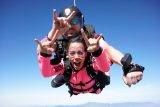
Unique California Experience Gifts for the Holidays
1 month ago by Skydive Perris
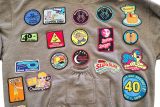
Skydiving Patches You Can Collect at Skydive Perris
3 months ago by Skydive Perris
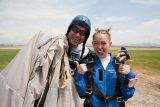
Famous People Who’ve Jumped at Skydive Perris
3 months ago by Skydive Perris
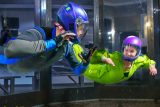
The Ultimate Family Hidden Gem in SoCal
6 months ago by Skydive Perris
